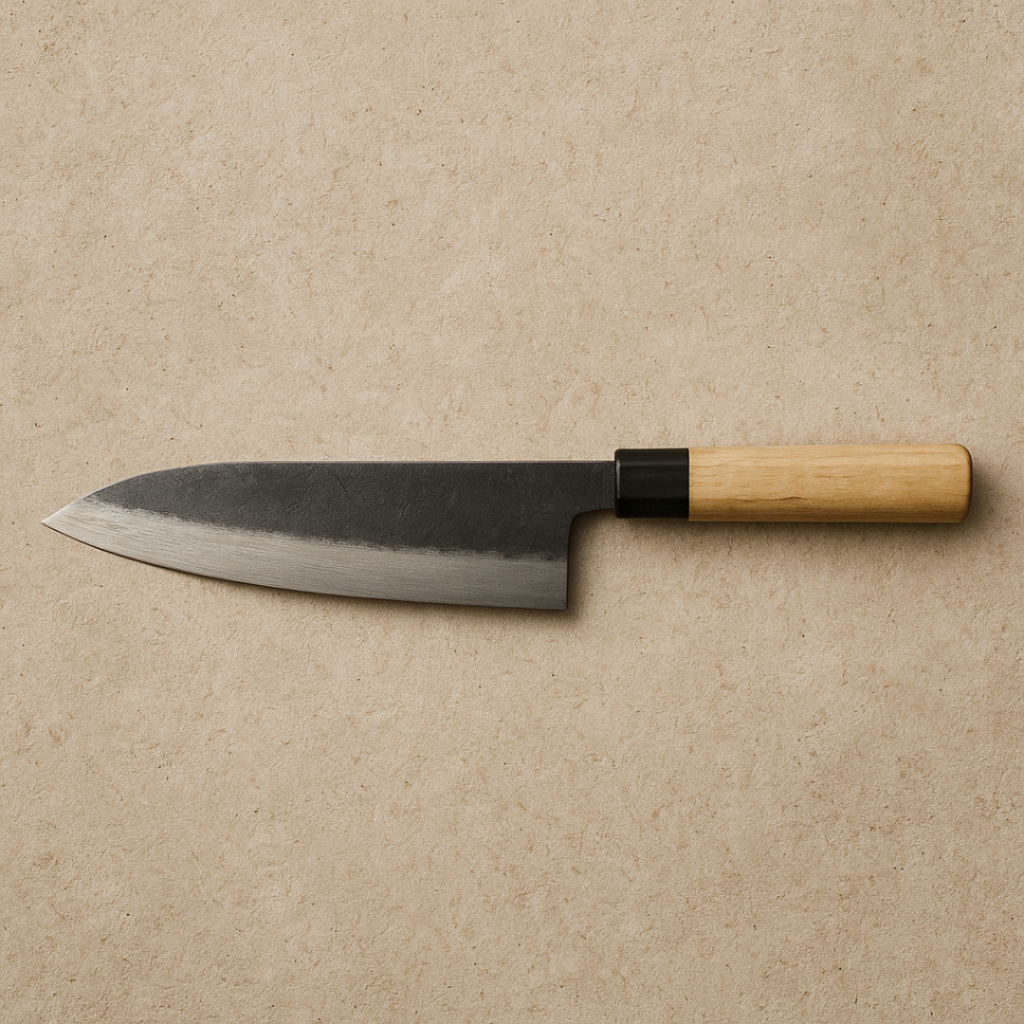Choosing between a Gyuto and a Santoku can feel like deciding between two masterpieces of Japanese craftsmanship. Both knives are versatile, both are rooted in tradition, and both deserve a place in the kitchen — but which one fits your cooking style best?
Quick Answer
The Gyuto is a Japanese chef’s knife with a longer blade, ideal for slicing meat, fish, and larger vegetables, while the Santoku is shorter and lighter, perfect for home cooking, push-cutting vegetables, and general all-purpose use.
The Gyuto: Japan’s Take on the Chef’s Knife
- Blade Length: Typically 210mm–270mm (8–10 inches)
- Shape: Longer, slimmer, with a pointed tip
- Best For: Precision slicing of meat, large vegetables, fish, and herbs
- Cutting Motion: Rock-chopping + slicing
The Gyuto (literally “beef-sword”) is Japan’s version of the Western chef’s knife. With its long, pointed blade, it’s designed for versatility and excels at slicing proteins. Chefs who prepare a wide range of ingredients — from roast beef to delicate herbs — often consider the Gyuto indispensable.
The Santoku: The All-Purpose Home Cook’s Knife
- Blade Length: Typically 165mm–180mm (6–7 inches)
- Shape: Shorter, wider, with a flatter belly
- Best For: Vegetables, boneless meat, fish, everyday prep
- Cutting Motion: Push-cutting, straight up-and-down motion
The Santoku translates to “three virtues” — cutting meat, fish, and vegetables. It’s a go-to knife for home cooks, valued for its balance, compact size, and efficiency. With a flatter edge profile, it encourages a clean push-cut rather than a rocking chop.
Side-by-Side Comparison: Gyuto vs Santoku
| Feature | Gyuto | Santoku |
|---|---|---|
| Blade Length | 8–10 in (210–270mm) | 6–7 in (165–180mm) |
| Tip Shape | Pointed, sharp tip | Rounded / “sheep’s foot” tip |
| Edge Profile | Curved belly, suited for rocking | Flatter belly, suited for push-cuts |
| Best Use | Professional kitchens, larger tasks | Home cooking, versatile prep |
| Strengths | Precision slicing, versatility, proteins | Compact, easy to handle, vegetables |
| Limitations | Requires more space and skill | Less efficient for big cuts of meat |


Which Knife Should You Choose?
- Choose a Gyuto if…
- You want one all-around chef’s knife.
- You cook a lot of meat or large ingredients.
- You prefer rocking motions when chopping.
- Choose a Santoku if…
- You cook mostly at home and want a lighter, shorter knife.
- You prep mostly vegetables and fish.
- You want a versatile starter Japanese knife.
Many chefs (and serious home cooks) actually own both: the Gyuto for heavy-duty slicing and the Santoku for quick everyday prep.
Care & Maintenance for Both Knives
- Always use a wooden or soft cutting board (Hinoki, maple).
- Hand wash and dry immediately — never dishwasher.
- Sharpen regularly with a whetstone (1000–3000 grit for maintenance, 6000+ for finishing).
- Store safely with a saya (sheath) or magnetic block.
See our guide: Knife Maintenance
Gyuto vs Santoku: Frequently Asked Questions
-
A Gyuto is a longer Japanese chef’s knife with a pointed tip, great for proteins and larger produce. A Santoku is shorter with a flatter edge, ideal for push-cutting vegetables and everyday home cooking.
-
Most beginners find the Santoku easier to control thanks to its shorter length and flatter belly. If you want one do-it-all blade and don’t mind extra length, start with a Gyuto.
-
Gyuto commonly runs 210–270 mm (8–10″), while Santoku is usually 165–180 mm (6–7″). Choose based on your board size, hand size, and typical ingredients.
-
Gyuto has a curved belly that favors rock-chopping and long slicing. Santoku has a flatter edge for push-cutting and precise up-down chops.
-
Yes. A Santoku handles boneless meat, fish, and poultry well. For big roasts or long slicing tasks, a Gyuto is more efficient.
-
Absolutely. A Gyuto is versatile across veg, herbs, and proteins. If you mainly prep vegetables, the Santoku’s flat profile can feel faster and tidier.
-
Both Gyuto and Santoku appear in carbon and stainless steels (e.g., White/Blue paper, VG-10, SG2/R2). Hardness is typically HRC 60–63, trading toughness for edge retention. See: Carbon Steel vs Stainless Steel.
-
For routine maintenance, use 1000–3000 grit; refine with 6000+ for a polished edge. Heavier repair may need 320–600 first. See: Knife Maintenance.
-
A Gyuto tends to be the best single “do-everything” knife, especially if you slice proteins often. A Santoku is superb for compact kitchens and veg-forward cooking.
-
Not required—but many cooks love the combo: Gyuto for long slicing and larger tasks; Santoku for quick everyday prep. Start with the one that matches your cooking style.
Explore more: Japanese Knife Shapes • Knife Maintenance • Carbon vs Stainless Steel




